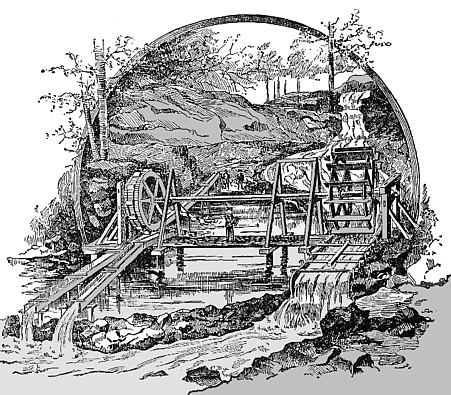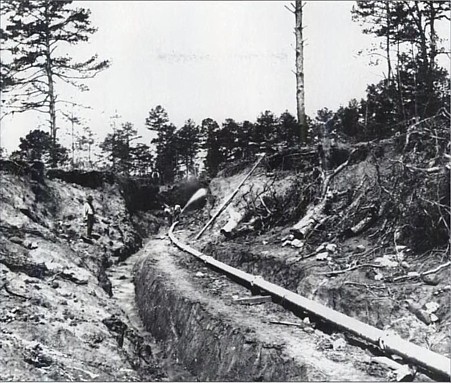The work of river-mining
may for convenience of consideration be subdivided as follows:
1. The use of temporary wing-dams, an upper and lower, built from the same
side of the stream and connected at their outer extremities by means of
another dam running parallel with the stream. The enclosed portion of the
river-bed may then be pumped out and mined. The obstruction to the stream
effected by this method of procedure is so comparatively small as not to
materially raise the level of the stream.
2. A section of a stream-bed may be exposed by building two dams across the
channel and conducting the water over them by means of a large flume which
is laid as near the low-water level of the stream as is practicable. The
water-level above the upper dam is by this method seldom raised more than
three or four feet above the normal.
3. The water of a stream may be diverted into a flume or tunnel in a manner
similar to that described above, by the use of one dam only, i.e., an upper
dam, which may or may not be permanent in character. The water-level is then
raised above the ordinary high water line, and a portion of the bed of the
stream below the dam is rendered dry.
4. River-mining may be carried on by means of shafts with their
accompaniment of hoisting and pumping plants situated on the bank of the
stream. Drifts are run along bed-rock under the channel. This method
resembles drift rather than river-mining.
5. Mining in streams by
means of elevators, dredges, vacuum pumps and similar devices, which are
usually installed on barges, being self-contained; all work is done beneath
the surface of the water. This method is considered under the heads of
Dredging and Hydraulic Elevators.
6. Deep-bar mining by shafts and drifts, is also a drift-mining method.
7. Deep-bar mining by a system of open-cut work in which power elevators and
hydraulic lifts are employed.
Wing-dams are of necessity temporary structures, being made at a cost exceeding but little that of the labor employed. They were used almost exclusively on the Feather, Yuba and American rivers in California, in 1854. A riffle is usually chosen as the starting point for the upper dam, two parallel walls of boulders being built at its upper end. These walls are usually about six feet apart, the space between being filled with gravel and sand, the coarser material occupying a position next the walls. After extending these walls as far as it is desired to work the stream-bed, they are turned down stream, and continued to the lower limit of the ground to be enclosed. They are finally turned on to another riffle if possible, and the lower dam is constructed, making connection with the bank. The mining ground is then completely walled in, and the work of freeing the enclosure from water is begun. Belt pumps working through wooden column pipes, commonly known as Chinese pumps, are usually employed, and are situated at the lowest point in the ground. These pumps are driven by current wheels, placed along side of the dam, paralleling the stream. Piles driven in the bed of the stream support the bearings of the wheel shaft, being protected and reinforced by large boulders piled around them. To permit the wheels to be kept in the same relative position with respect to the water-level the bearings or pillow blocks are placed in vertically grooved supports, which are adjusted by levers. In order to more effectively control the current of the stream and keep it directed against the wheel another wing-dam may be built extending from the opposite side or bank of the river. These wheels are made as cheaply as possible, as they are especially liable to sustain damage by floods.
Aside from the dams, wheels and pumps, the only appliances necessary for working a river mine are: Picks shovels, wheelbarrows, sluice boxes and derricks. The derricks may also be operated by water wheels. As the washing of the. gravel taken from the river-bed is done in the pit it is necessary to provide water for the operation, but the water so used as well as the tailing produced must not be discharged into the pit, as it would necessitate a second handling. Water for washing is let in through the head dam, but if the grade is not sufficient for the discharge of the tailing over the tail dam, the sluices must be raised and additional water provided by a so-called dip wheel also mounted without the dam and driven by the current. These wheels vary from 20 to 26 feet in diameter and 4 to 6 feet in width. The gold almost invariably occurs on the bed-rock and in its irregularities and crevices, although the overlying gravels may contain natural gold for a distance of a few inches to 15 to 20 feet above bed-rock. Above the pay gravel there usually occurs a mass of boulders and gravel containing little or no gold. The boulders are removed by derricks while the gravel and sands are wheeled out by wheelbarrows. When pay gravel is reached it is taken out to bed-rock and washed in sluices, the bed-rock also receiving careful attention being washed and creviced with spoons and knives.
The work of river-mining when once begun is rushed forward both night and day, with all possible haste, owing to the shortness of the season. When rising water threatens the operations the derricks are first secured, following which the pumps, wheels, etc. River-mining by fluming, although more expensive and uncertain than the use of wing-dams, is applicable to more extensive operations, but must of necessity be confined to the shorter seasons and smaller streams, while wing dam mining may be employed in streams of any size, and is an inexpensive and rapid operation. To gain time the construction of the flume is begun first of all, and as it cannot be built under water, operations cannot begin until moderately low-water is obtained. The flume is built on the bank of the river, often right in the water, in order that it may be as low as possible. The dimensions and grade must vary with the quantity of water to be handled. However, sufficient grade should be provided for to give enough power to drive current wheels, and to keep down weight in flumes by reducing height of water. While not peculiar to California, river-bed mining has been pursued here on a scale not paralleled in other countries, and the efficiency of the methods developed during the California gold rush greatly surpass those employed elsewhere. Working the beds of the rivers that traverse the gold mining regions of California was begun here at an early day. During 1852, 1853 and 1854 river-mining yielded a large part of the gold mined in California, during which time all of the large rivers were extensively worked. The first crop of gold nuggets and dust harvested by this method was very bountiful. Like some other kinds of gold mining here, this branch of the business, after having prospered and attained large dimensions, underwent a marked decline as all the workable sections were processed.
Gradually with the accessible river beds worked and workable benches and low alluvium supplies also becoming short, attention was turned in 1852 to the high hill deposits the buried rivers. These immense alluvial banks, often capped with basalt, sometimes have a depth (or 'face') of over 600 ft., and as the richest stratum usually lies near the bottom, the grade of material was found to be, as a rule, lower in gold content than the deposits already described.
Continue on to:
Old Time Hydraulic Placer Mining Methods, Part I
Return To:
Historic Placer Mining Technologies


